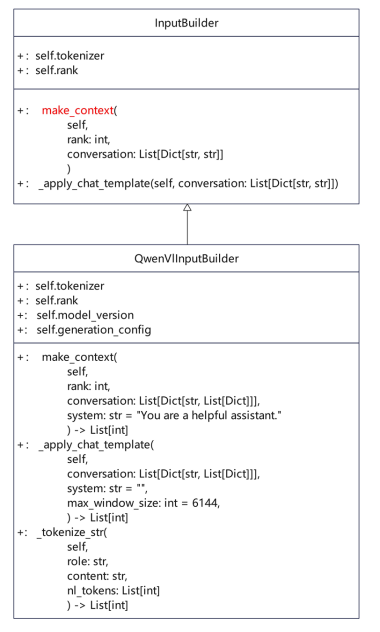服务侧接收到请求之后会调用tokenize(),当请求是OpenAI的格式时,将调用模型侧的InputBuilder类的make_context()接口。
- InputBulder类
适配新的多模态模型对接服务化时,需要创建一个新的子类“XXXInputBuilder”继承基类“InputBuilder”,并重写make_context()这个类方法。
以Qwen-VL为例 ,下面是QwenVlInputBuilder的类图。完成该类重写后,需要在模型的Router的get_input_builder()中完成示例化。对应文件路径位于“/usr/local/Ascend/atb-models/atb_llm/models/qwen/router_qwen.py”

- make_context() 函数输入
OpenAI格式的请求,在输入上变为了List[Dict[str, Dict]]格式,可以支持多轮对话的输入。每一轮对话是Dict,其中多出了两个字段“role”和“content”,“role”表示这一轮对话的角色,“content”表示这一轮对话的内容,其格式与1一致。
代码示例如下:
1 2 3 4 5 6 7 8 9 10 11 12 13 14 15 16 17 18
[ { "role": "user", "content": [ {"image": "/XXX/XXX/image.png"}, {"video": "/XXX/XXX/video.mp4"}, {"audio": "/XXX/XXX/audio.mp3"}, {"text": "What is in the image?"} ] }, { "role": "assistant", "content": [ {"text": "A cute panda."} ] } ... ]
- make_context() 函数实现
这个函数实现的目的与tokenize()是一致的,都是将输入转换为input_ids。不过这个函数通常是以模型支持的chat template来安排整个内容。
此函数的实现步骤与tokenize()函数的一致,主要是多了下面的步骤b.。下面的实现步骤顺序不强制,可以按照实际实现调整。
- 将输入转换为Str类型的query,并且用特殊的token作为分割。
- 按照template拼接内容。
- 对转换后的query进行encode,得到token_ids。
- 遍历输入,加载并处理多媒体数据,计算input_ids的大小,进行padding。
- 将处理好的pixel_value数据存入共享内存。
- 将共享内存的name和存入数据的shape进行编码。
- 将编码好的name和shape嵌入input_ids中,返回一维的torch.Tensor(device=cpu)类型的input_ids。
代码示例如下:
1 2 3 4 5 6 7 8 9 10 11 12 13 14 15 16 17 18 19 20 21 22 23 24 25 26 27 28 29 30 31 32 33 34 35 36 37 38 39 40 41 42 43 44 45 46 47 48 49 50 51 52 53 54 55 56 57 58 59 60 61 62 63 64 65 66 67 68 69 70 71 72 73 74 75 76 77 78 79 80 81 82 83 84 85 86 87 88 89 90 91 92 93 94 95 96 97 98 99 100 101 102 103 104 105 106 107 108 109
def make_context( self, rank: int, conversation: List[Dict[str, List[Dict]]], system: str = "You are a helpful assistant.", **kwargs): if self.generation_config["chat_format"] != 'chatml': raise ValueError(_ERROR_BAD_CHAT_FORMAT) if not isinstance(conversation[0]["content"], list): raise ValueError("The conversation \"content\" should be a List[Dict].") shm_name_save_path = kwargs.get('shm_name_save_path', None) self.rank = rank max_window_size = kwargs.get('max_window_size', None) if max_window_size is None: max_window_size = self.generation_config["max_window_size"] context_tokens = self._apply_chat_template( conversation, system=system, max_window_size=max_window_size, shm_name_save_path=shm_name_save_path, ) return context_tokens def _apply_chat_template( self, conversation: List[Dict[str, List[Dict]]], system: str = "", max_window_size: int = 6144, shm_name_save_path: str = None, **kwargs): # 1. 获取特殊 Token im_start_tokens = [self.tokenizer.im_start_id] im_end_tokens = [self.tokenizer.im_end_id] nl_tokens = self.tokenizer.encode("\n") system_tokens_part = self._tokenize_str("system", system, nl_tokens) system_tokens = im_start_tokens + system_tokens_part + im_end_tokens shm_name_list = [] shape_value_list = [] content_key = "content" image_key = "image" for message in conversation: for single_input in message[content_key]: if image_key not in single_input.keys(): continue # 4. 遍历输入,加载并处理多媒体数据,计算`input_ids`的大小,进行`padding` image_pixel = _image_preprocess(single_input[image_key]) image_pixel = image_pixel[None, :] if shm_name_save_path is None: shm_name_save_dir = os.path.dirname(os.path.dirname(single_input[image_key])) shm_name_save_path = os.path.join(shm_name_save_dir, "shm_name.txt") shm = shm_utils.create_shm(image_pixel.nbytes, shm_name_save_path) shared_array = np.ndarray(image_pixel.shape, dtype=np.float32, buffer=shm.buf) shared_array[:] = image_pixel # 5. 将处理好的`pixel_value`数据存入共享内存 # 6. 将共享内存`name`和存入数据的`shape`编码 shm_name = shm_utils.encode_shm_name_to_int64(shm.name) shape_value = shm_utils.encode_shape_to_int64(image_pixel.shape) shm_name_list.append(shm_name) shape_value_list.append(shape_value) # 1. 将输入转换为`Str`类型的`query`,并且用特殊的`token`作为分割 context_tokens = system_tokens query = self.tokenizer.from_list_format(conversation.pop()[content_key]) for message in conversation[::-1]: turn_query = self.tokenizer.from_list_format(message[content_key]) if message["role"] == self.user_role_name: query_tokens = nl_tokens + im_start_tokens + \ self._tokenize_str(self.user_role_name, turn_query, nl_tokens) + im_end_tokens + nl_tokens elif message["role"] == self.system_role_name: query_tokens = im_start_tokens + \ self._tokenize_str(self.system_role_name, turn_query, nl_tokens) + im_end_tokens else: raise ValueError(f"message role not supported yet: {message['role']}") current_context_size = ( len(system_tokens) + len(query_tokens) + len(context_tokens) ) if current_context_size < max_window_size: context_tokens = query_tokens + context_tokens else: break # 2. 按照`template`拼接内容 context_tokens += ( nl_tokens + im_start_tokens + self._tokenize_str(self.user_role_name, query, nl_tokens) # 对转换后的`query`进行`encode`,得到`token_ids` + im_end_tokens + nl_tokens + im_start_tokens + self.tokenizer.encode(self.system_role_name) + nl_tokens ) # 7. 将编码好的`name`和`shape`嵌入`input_ids`中,返回一维的`torch.Tensor`(cpu)类型的`input_ids` context_tokens_tensor = torch.tensor(context_tokens) bos_pos = torch.where(torch.eq(context_tokens_tensor, self.image_start_id))[0] image_num = bos_pos.shape[0] for i in range(image_num): context_tokens[bos_pos[i] + 1] = shm_name_list[i] context_tokens[bos_pos[i] + 2] = shape_value_list[i] return context_tokens
- Router 中重写 get_input_builder()
服务侧会通过模型的Router的get_input_builder()接口获取每个模型侧InputBuilder,因此请务必重写该函数。